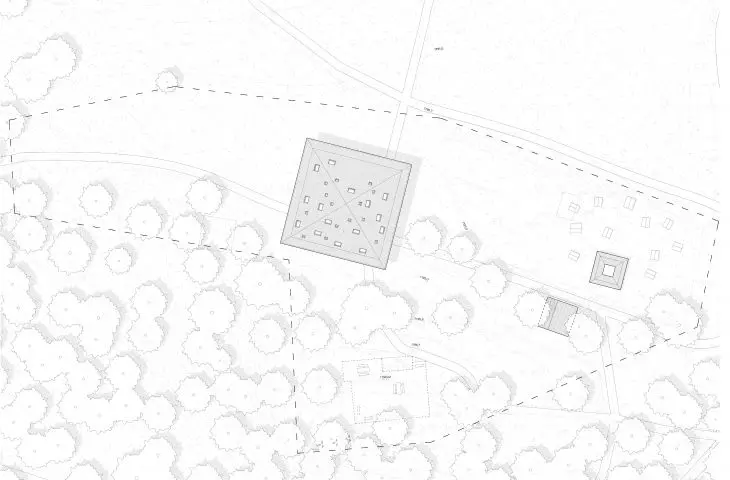From the Faculty of Architecture at the Warsaw University of Technology, {tag:studenci}, interested in the history of the mountain shelter on Luban and the competition for its model design conducted by the SARP Krakow branch in 2020, also decided to take on this architectural challenge. Her concept for a new building on Luban refers to the archetype of the shelter and interprets regional architecture, focusing on the characteristic shingled roofs.
history of the shelter and the competition
The Luban range in the Gorce Mountains is traversed by the Main Beskid Trail, where on the route from Krościenko nad Dunajcem to Turbacz, there are no permanent facilities allowing rest, accommodation or shelter. The glade at the top of Luban once offered such assistance to tourists. In 1937, a shelter was built under the summit of Luban, which was burned down by the Nazis in 1944. Only the ground-level ruins remain. In 1976, PTTK built a small mountain shelter slightly below the summit of Luban on the Wyrobki Glade, which burned down completely in 1978, Agata Kobus says.
site development plan
© Agata Kobus
In autumn 2020, at the request of the Polish Tourist Society, SARP Krakow branch announced an international, one-stage, implementation architectural and urban planning competition, aimed at obtaining the best solution for the building of a model mountain host el on Luban. The competition was won by a team consisting of: Slawomir Janas Pracownia ES-JOT, Bartosz Pionka Pracownia Architektoniczna and Architect Michal Włoskowicz. Work is currently underway on the cost estimate and the regulation of land ownership. Full results of the competition and its guidelines are available here. Currently, a tent base, located in a clearing, and a viewing tower directly located on the summit, operate in the vicinity of the trails.
The shelter is characterized by a black shingled roof
© Agata Kobus
A new look at the hostel on Luban
Agata Kobus from the Faculty of Architecture at the Warsaw University of Technology was so interested in the topic of the hostel, especially its history, that she tried to tackle its design as part of her engineering degree. Her work was created under the direction of Dr. Piotr Trębacz and Dr. Rafal Mazur.
The goal of my project was to conduct a deep analysis of the landscape, the proposed solutions in the competition and find the best possible architectural answer for the tourists visiting the site, as well as for the surrounding nature. The designed object is to become a natural complement to the existing space of the landscape and the needs born on top of the mountain," explains the author.
first floor plan of the designed hostel
© Agata Kobus
The author's urban planning assumption was to interfere as little as possible with the existing environment, respecting its history. The development project for the complex can be divided into three parts: the hostel building, the tent base and the historical part - the ruins. After analysis, the designer discussed the local plan (established on December 30, 2014) and considered a different location for the building than the suggested one. All this was done to avoid devastation of the historic ruins and to prevent tree cutting. The orientation of the proposed building was adjusted to the hiking trails running through the plot, thus making the shelter one of the stops on the trail.
The author placed great design emphasis on the structure
© Agata Kobus
The roof as an archetype of a shelter
The object proposed by Agata Kobus in its architectural form refers to the roof shown as an archetype of a shelter, forming a compact form. The author, referring to Juliusz Zorwaski's book "On the Construction of Architectural Forms", referred to the theme of cohesive forms through the design of the roof, which is a symbol of shelter.
The shelter consists of four levels, and its first floor is open to the surrounding clearing
© Agata Kobus
The designed shelter offers travelers a summer cafe, restaurant, accommodation and a place where everyone can rest for a while. The building is simple in both its form and functional palette. The author opened the first floor to a neighboring clearing, which can encourage people to stay outdoors. Meanwhile, the ruins of the pre-war hostel were highlighted in the form of a memorial. Pro-environmental solutions were also an important aspect - a conscious choice of materials, construction and installation solutions in the building.
"In the design I refer to the characteristic geometry of the roof and caricature it," he says.
© Agata Kobus
regional context for inspiration
The regional architecture of the surrounding area is very diverse. In it, one can observe a strong dominance of the roof in the building masses. A characteristic element of the roofing is the change of angle in its geometry. In the project I refer to the characteristic geometry of the roof and caricatureit . It becomes the main theme. An important element in the design was the use of materials that directly relate to the immediate surroundings, but also those that will respectfully relate to the environment within the framework of sustainable architecture. Therefore, the design decision was, among other things, wood, wooden shingles on the roofing, or clay plaster on the facade," concludes Agata Kobus.







































































